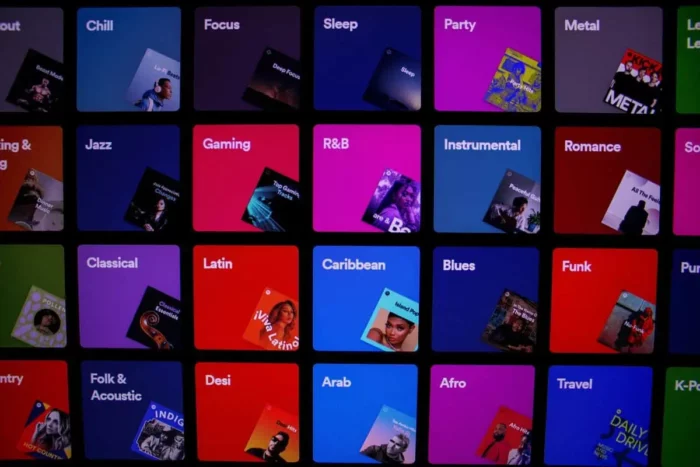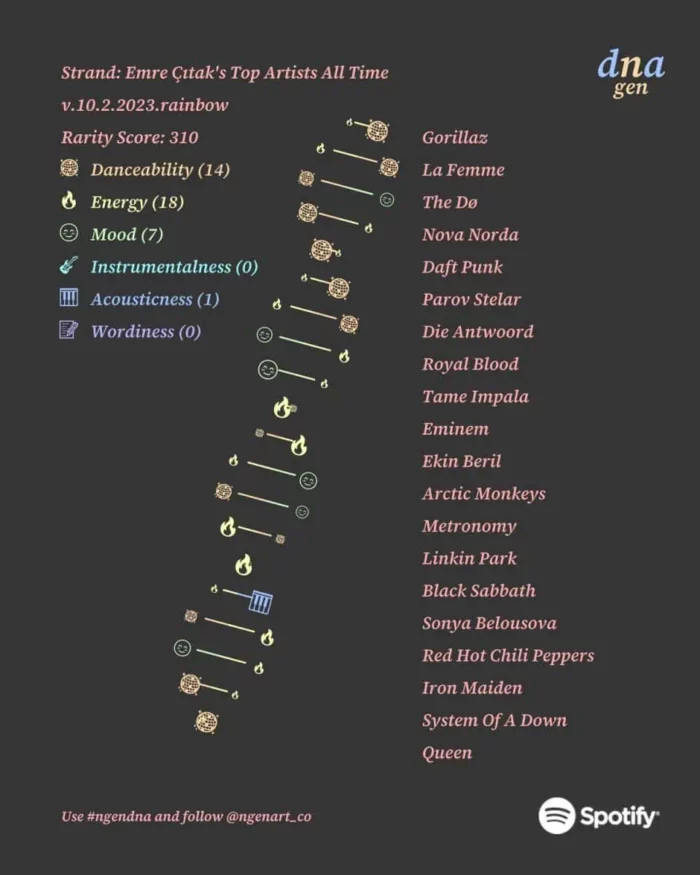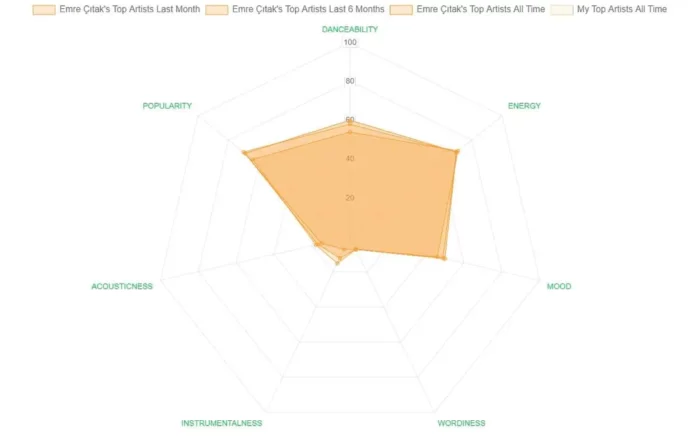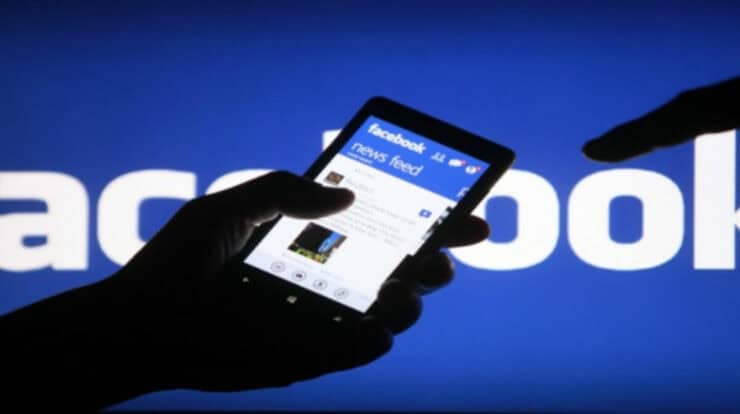
The third-party website known for creating viral content on Spotify, n-gen Art, has returned with the Spotify DNA chart. This innovative feature transforms your music listening patterns into a visual representation that resembles a DNA helix.
The cutting-edge viral art generator n-gen has recently upgraded its features, unveiling a new Spotify DNA chart tool. This latest enhancement lets users track the progression of their music preferences, observing the changes in their favorite musicians and music styles over time.
Listeners can now create personalized and evolving art pieces based on the data from their Spotify accounts, which mirror their distinctive music-listening patterns.
What is Spotify DNA Chart?
The n-GEN platform now incorporates the Spotify DNA chart into its collection of inventive resources. These resources already offer the ability to produce artwork inspired by preferred playlists and dissect your musical tastes to craft unique creations. This new addition elevates the platform’s ability to deliver unmatched personalization and understanding of individual music tastes.
The Spotify DNA chart, as described on the website, aims to give users a graphic display of their listening habits, highlighting the evolution of their musical preferences through time. This tool is set to offer an enjoyable and insightful experience for all kinds of music enthusiasts, from those who consider themselves connoisseurs to those who take pleasure in finding fresh tracks.
How to Get Your Spotify DNA Chart?
The cutting-edge viral art generator recently introduced a new function enabling the creation of a distinctive DNA diagram influenced by the music you frequently listen to on Spotify. This is the process for obtaining your personalized Spotify DNA chart:
- Visit the website at ngenart.com/spotify/dna.
- Click “Connect with Spotify“
- Sign in to your account and authorize n-GEN-art to access your Spotify information.
- Select the specific group or compilation of songs you wish to utilize for your genetical blueprint representation.
- Once you have chosen the desired category or playlist, continue scrolling down and then select the “Share card” option.
Additionally, you have the option to personalize the backdrop of the Spotify DNA chart by selecting from a variety of pre-designed background choices.
- Cereal
- Midnight
- Rainbow
- Frankenstein
- Fire
- Ice
- Banana
- Lavender
- Evergreen
- Strawberry
- Avocado
- Barbie
There you have it! By following these easy instructions, you can reveal the distinctive combination of music that characterizes your personal taste and predilections.
Next, for every track, n-GEN extracts six particular characteristics. Spotify API of the platform evaluates several attributes including how widespread and liked it is, its suitability for dancing, the level of vigor it exudes, the emotional tone it carries, the extent to which it is unplugged or not reliant on electronic instruments, and the degree of its lyrical complexity or verbosity.
Here’s what each trait means:
Popularity
This gauges the level of recognition a track has achieved, considering aspects such as its play count and the recency of these plays. A popularity rating of 100 signifies that the track is extremely popular and has been played often, whereas a rating of 0 implies that the track is not widely recognized.
Danceability
This passage explains the degree to which a song is apt for dancing, considering elements such as its pace, the consistency of its rhythm, the intensity of its beats, and its general uniformity. A danceability rating of 100 signifies that the track is highly conducive to dancing, whereas a rating of 0 implies that it is not particularly suitable for dance.
Energy
This gauges the vibrancy and dynamism of a song, taking into account aspects such as speed, volume, and sound density. A rating of 100 for energy signifies that the track gives off a highly lively sensation, whereas a rating of 0 implies it has a calmer, more subdued quality.
Mood
This evaluates the sentiment conveyed by a track, considering elements such as tune, chords, and words. A mood rating of 100 reflects that the track has a highly upbeat sound (for instance, joyful, lively, or ecstatic), whereas a rating of 0 implies that it has a darker sound (for example, melancholic, despondent, or irate).
Acousticness
This metric determines the extent to which a track gives off an acoustic vibe, which depends on elements such as the use of acoustic instruments and the lack of electronic instruments. A score of 100 in acousticness means the track appears highly acoustic, whereas a score of 0 implies it has a less acoustic sound.
Wordiness
This identifies if there are spoken words in a song. Recordings that are mostly like speech, such as talk shows, audiobooks or poetry readings, will have an attribute value nearing 100. Tracks with values over 66 are likely composed entirely of spoken word content. Those with values ranging from 33 to 66 could have a mix of music and spoken words, possibly with the words over music or in separate parts, as is common with rap music. Tracks with values under 33 are usually music or other types of audio that don’t resemble speech.
Upon examining your listening history, the n-GEN system determines your most frequently played songs. It then applies six distinct characteristics to craft a visual depiction that reflects your individual music preferences. This chart illustrates your tendencies in areas like popular appeal, rhythm suitable for dancing, vibrancy, emotional tone, degree of acoustic elements, and the extent of lyrical content, using varied colors to denote each trait’s intensity or presence.
ALSO SEE:
- FastDL Downloader
- What Is Docsity
- GenYoutube
- Snokido
- What is Onlyfinder
- Instagram Camera Not Working
Not the Spotify DNA you were looking for?
Spotify has partnered with Ancestry.com to offer a one-of-a-kind auditory experience: playlists tailored to your genetic background. Collaborating with the leading genealogy company, Spotify seeks to deliver music playlists that mirror the user’s ancestral roots.
Here’s how it works: simply sign up for Ancestry.com’s DNA testing service (which includes a one-time fee of $99) and trace your family tree. Once you have your results, input them into Spotify’s playlist generator, and then you’ll receive a personalized playlist tailored to your ancestral roots.





